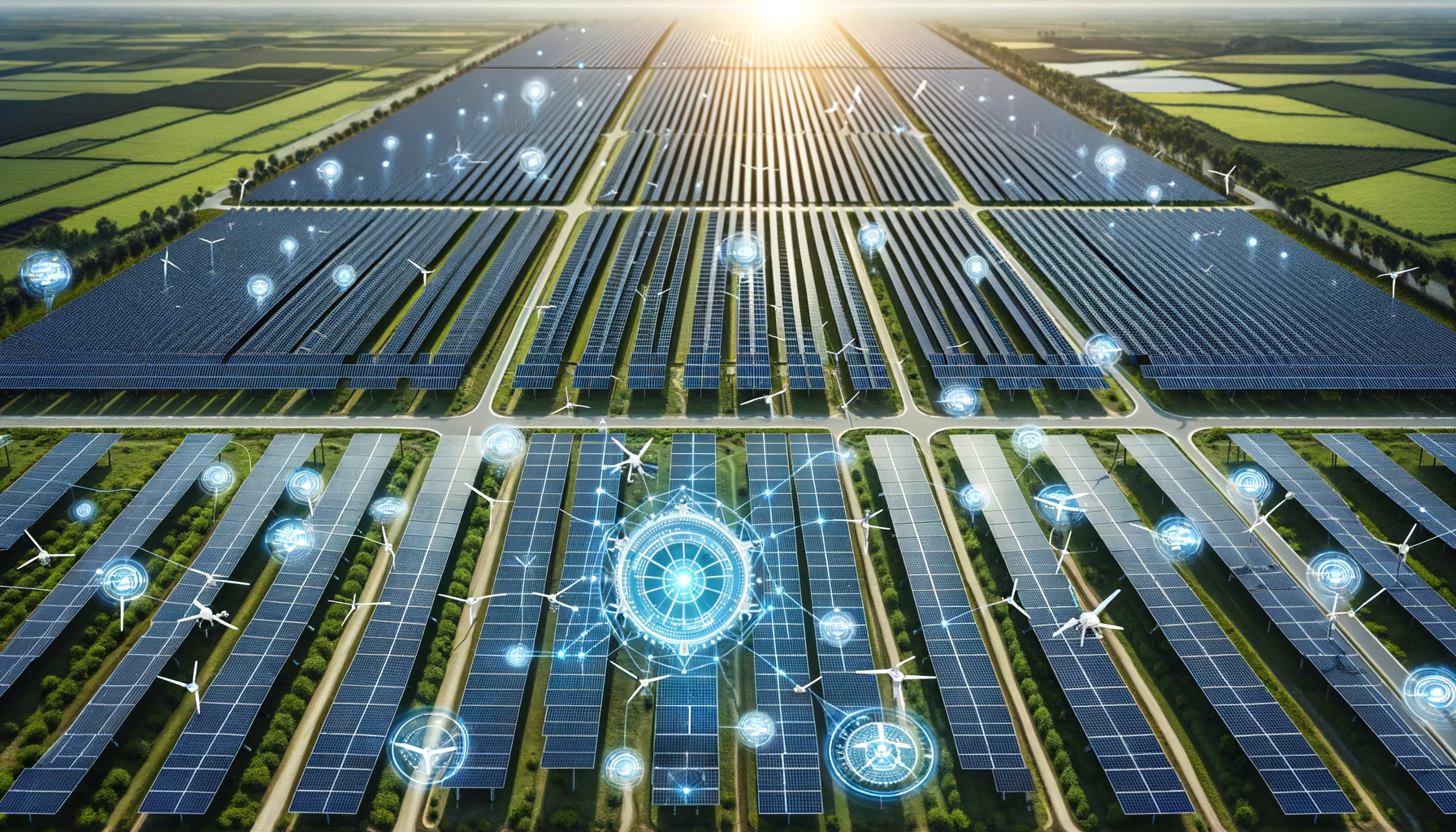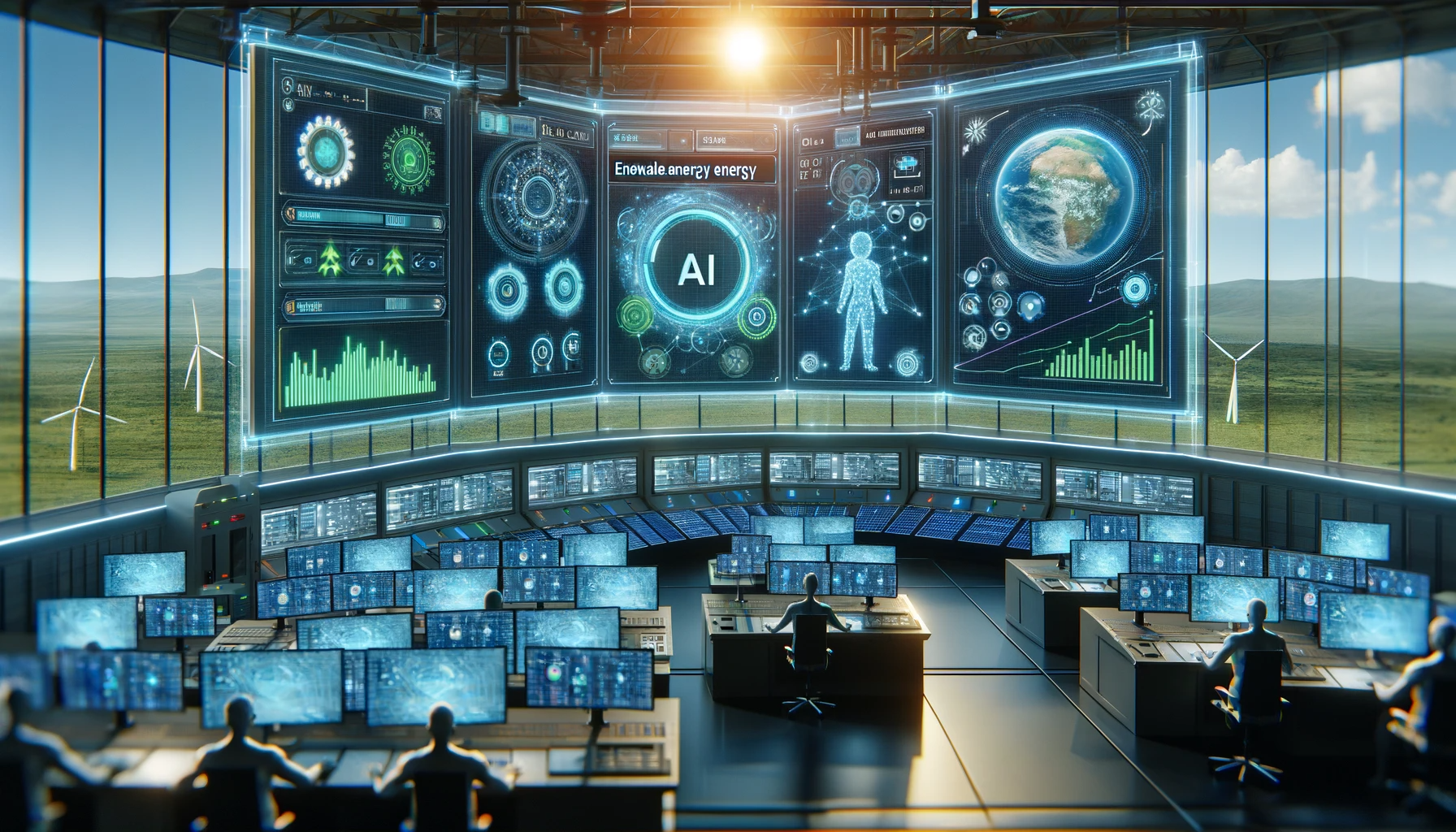In the face of accelerating climate change and the global imperative to transition to sustainable energy sources, renewable energy has emerged as a beacon of hope in the pursuit of a greener future. Wind, solar, hydro, and other renewable sources hold immense potential to reduce greenhouse gas emissions and mitigate the impacts of our carbon-intensive energy systems. However, realizing this potential hinges not only on increasing the generation of renewable energy but also on efficiently managing and distributing it.
Enter Artificial Intelligence (AI), a technological force poised to revolutionize the renewable energy landscape. As humanity grapples with the complexities of harnessing the intermittent nature of renewables and building smarter energy grids, AI emerges as a transformative ally. Its capacity to analyze vast datasets, make predictions, and optimize operations offers a compelling solution to the challenges of renewable energy management and distribution.
This article embarks on a journey through the intersection of AI and renewable energy. We delve into the possibilities, exploring how AI can usher in a new era of sustainable energy systems. From predictive models that anticipate energy production to smart grid management that optimizes distribution, we uncover the myriad ways in which AI is reshaping the renewable energy landscape.
As we navigate this transformative landscape, we must not only celebrate the promises of AI but also grapple with the challenges and limitations it presents. Privacy concerns, data quality, and the need for regulatory frameworks underscore the importance of a nuanced perspective on AI’s role in renewable energy.
Join us as we journey into the world of AI-driven renewable energy management and distribution, where innovation meets sustainability, and where the power of technology converges with the power of nature in our quest for a cleaner and more sustainable future.

The Promise of AI in Renewable Energy
Renewable energy sources, such as solar and wind power, have made significant strides in reducing carbon emissions and addressing the global climate crisis. However, they bring unique challenges due to their intermittent nature, which can result in unpredictable energy generation. This unpredictability poses a considerable challenge for grid operators, making it challenging to balance energy supply and demand efficiently.
Artificial Intelligence (AI) has emerged as a beacon of hope in addressing these challenges. AI, with its advanced data analytics and machine learning capabilities, holds the promise of optimizing renewable energy systems and revolutionizing the way we generate, manage, and distribute clean energy.
One of the primary ways AI enhances renewable energy systems is through predictive models. AI algorithms can process vast amounts of data, including historical energy production, weather patterns, and real-time monitoring. By analyzing this data, AI can create highly accurate forecasts of energy production from renewable sources. These predictive models enable grid operators to anticipate energy surges and lulls, allowing for better grid management and resource allocation.
Furthermore, AI can facilitate real-time adjustments to energy production and distribution. For instance, if a cloud passes over a solar farm, temporarily reducing sunlight, AI can detect this change and redirect energy from other sources to compensate. This dynamic response improves the reliability and stability of renewable energy systems, making them more adaptable to varying conditions.
Predictive Models for Energy Production
A cornerstone of AI’s transformative role in renewable energy is its ability to create predictive models for energy production. This capability is particularly crucial for addressing the intermittent nature of renewable sources like solar and wind.
AI-driven predictive models rely on a multitude of data sources. Historical energy production data, weather forecasts, satellite imagery, and even social and economic factors can be integrated into these models. Machine learning algorithms analyze this data to make accurate predictions about energy generation, helping grid operators make informed decisions.
For example, consider a wind farm. AI can analyze historical wind patterns specific to the farm’s location, taking into account seasonal variations and weather forecasts. By continuously monitoring real-time wind conditions and comparing them to predictions, AI can adjust the farm’s operations to maximize energy output. If a lull in wind is expected, AI can allocate energy from other sources to ensure a consistent power supply.
These predictive models have tangible benefits. They optimize the use of renewable energy sources, reducing waste and reliance on backup fossil fuel power. They also improve energy grid stability by providing advanced notice of fluctuations in energy production, allowing grid operators to take preventive measures.
Smart Grid Management
A critical component of modernizing renewable energy distribution is the development of smart grids. Smart grids are intelligent, digitally connected systems that optimize the generation, distribution, and consumption of electricity. AI plays a pivotal role in making smart grids smarter.
AI-driven smart grid management offers several advantages. Firstly, it enhances the overall efficiency of energy distribution. By analyzing real-time data from various sensors and sources, AI can detect and respond to fluctuations in demand and supply. This dynamic balancing ensures that electricity is distributed optimally, minimizing waste and reducing costs.
Additionally, AI improves grid resilience and reliability. It can identify and isolate faults or disturbances in the grid, preventing localized issues from cascading into large-scale blackouts. Moreover, AI can reroute energy flows to minimize disruptions during outages or maintenance, ensuring that consumers experience minimal downtime.
Furthermore, smart grids equipped with AI can facilitate the integration of distributed energy resources, such as rooftop solar panels and home battery systems. AI can manage these decentralized energy sources efficiently, enabling consumers to sell excess energy back to the grid or store it for later use. This democratizes energy production and consumption, empowering individuals and communities to participate actively in the renewable energy transition.
In summary, AI-driven smart grid management optimizes energy distribution, enhances grid resilience, and empowers consumers to be active participants in the renewable energy ecosystem. It is a critical piece of the puzzle in achieving a sustainable and reliable energy future.
Challenges and Limitations
While the promise of AI in revolutionizing renewable energy management is immense, it is not without its challenges and limitations. Acknowledging and addressing these issues is crucial for the effective integration of AI into the renewable energy sector.
One significant challenge lies in the quality and availability of data. AI algorithms heavily rely on data for training and decision-making. Inaccurate or incomplete data can lead to erroneous predictions and suboptimal grid management. Ensuring data quality and accessibility, particularly in remote or underserved areas, remains a pressing concern.
Privacy and cybersecurity are also paramount concerns. As AI systems collect and analyze data from various sources, protecting the privacy of individuals and the security of energy infrastructure becomes increasingly critical. Safeguarding against cyberattacks that could disrupt AI-driven energy systems is a constant battle.
The cost of implementing AI solutions in the renewable energy sector is another consideration. While the long-term benefits may justify the investment, initial setup costs can be substantial. Smaller organizations and regions may face financial barriers to adopting AI-powered technologies.
Moreover, the scalability of AI solutions is essential. Ensuring that AI-driven renewable energy systems can be scaled up to meet the growing demand for clean energy is crucial for the widespread adoption of these technologies.
Case Studies and Success Stories
To better understand the real-world impact of AI in renewable energy management and distribution, we turn to inspiring case studies and success stories from around the world.
One compelling example comes from the city of Helsinki, Finland, where an AI-driven heating system has transformed the district heating network. By analyzing weather data and energy consumption patterns, AI adjusts the heat production to match demand precisely. This optimization has reduced energy waste and lowered costs for both the city and its residents.
In the United States, the state of California has leveraged AI to improve the efficiency of its electricity grid. Through advanced forecasting and real-time monitoring, California’s grid operators can better integrate renewable energy sources, resulting in reduced emissions and increased grid reliability.
Another noteworthy success story comes from India, where AI-powered microgrids are bringing electricity to rural communities. These microgrids analyze local energy production and consumption patterns, ensuring a stable and reliable power supply to previously underserved areas.
These case studies illustrate how AI can be tailored to the specific needs and challenges of diverse regions and energy systems. They showcase the tangible benefits of AI in enhancing energy efficiency, reducing costs, and accelerating the transition to clean energy sources.

Future Prospects and Conclusion
As we peer into the future, the prospects for AI in renewable energy management and distribution appear increasingly promising. AI will continue to evolve, offering even more sophisticated tools for optimizing renewable energy systems. Predictive models will become more accurate, smart grids more intelligent, and the integration of AI with renewable energy resources more seamless.
In conclusion, the symbiotic relationship between AI and renewable energy offers a path towards a more sustainable and greener future. AI’s capacity to analyze vast datasets, make informed predictions, and optimize energy distribution is a game-changer in our quest to combat climate change and transition to clean energy sources. However, it is vital to recognize and address the challenges and limitations to ensure that the benefits of AI are accessible to all and do not compromise data security or privacy.
As we move forward, collaboration between governments, industries, and researchers will be crucial in harnessing the full potential of AI in renewable energy. By embracing AI-driven innovations, we can accelerate the global transition to a cleaner, more sustainable, and resilient energy future.
